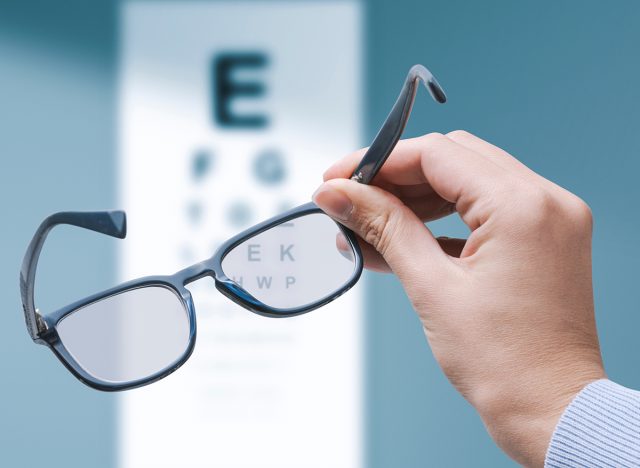10 Long-Term Possible Side Effects of Ozempic

Ozempic is the most well-known semaglutide medication being used right now, thanks to many celebrities openly (and not so openly!) using the drug for weight loss. Although Ozempic is highly effective as a weight loss drug, technically, it's meant to be used as a type 2 diabetes medication, which is what it was created for. Although it's only recently that the drug has been trending, Ozempic was approved by the FDA in 201—so we have at least seven years of data to go on when it comes to side effects. Here are ten possible long-term side effects of using Ozempic, according to studies and official company information.
Inflammation of the Pancreas

Ozempic can cause pancreatitis, according to the official warning label: "Stop using Ozempic and call your healthcare provider right away if you have severe pain in your stomach area (abdomen) that will not go away, with or without vomiting. You may feel the pain from your abdomen to your back."
Changes in Vision

Ozempic can cause vision issues. "It may seem strange that a drug made to help control diabetes could make your eyesight worse, but it's something we've known about for a while," says Raj K Maturi, MD. "A large clinical study suggested an association between blood sugar control and worsening of diabetic retinopathy."
RELATED: 20 Incredible Ozempic Success Stories of All Time
Low Blood Sugar

Ozempic can cause hypoglycemia in some people. "Signs and symptoms of low blood sugar may include: dizziness or lightheadedness, blurred vision, anxiety, irritability or mood changes, sweating, slurred speech, hunger, confusion or drowsiness, shakiness, weakness, headache, fast heartbeat, and feeling jittery," Ozempic makers warn.
Kidney Problems

Ozempic can cause kidney problems and kidney failure. "In people who have kidney problems, diarrhea, nausea, and vomiting may cause a loss of fluids (dehydration), which may cause kidney problems to get worse," Ozempic makers warn. "It is important for you to drink fluids to help reduce your chance of dehydration."
However, research shows taking Ozempic actually shows benefits for kidney disease. "We are ecstatic that we are seeing real benefits for people with chronic kidney disease," Katherine Tuttle, a nephrologist at the University of Washington School of Medicine in Spokane who co-ran the trial, tells Nature. "These patients benefit broadly."
Serious Allergic Reactions

Some people may have an allergic reaction to Ozempic, and should stop taking it immediately. "Get medical help right away if you have any symptoms of a serious allergic reaction, including swelling of your face, lips, tongue, or throat; problems breathing or swallowing; severe rash or itching; fainting or feeling dizzy; or very rapid heartbeat," the makers warn.
RELATED: 20 Things You Need to Know About Ozempic and Weight Loss
Gallbladder Problems

Some people who take Ozempic experience gallbladder issues. "Given the wide use of these drugs, these adverse events, although rare, must be considered by patients who are contemplating using the drugs for weight loss because the risk-benefit calculus for this group might differ from that of those who use them for diabetes," according to research published in the Journal of the American Medical Association.
Nausea and Vomiting

Some people on higher doses of Ozempic experience nausea and vomiting. The makers have advice to lessen the symptoms:
- Eat bland, low-fat foods, like crackers, toast, and rice
- Eat foods that contain water, like soups and gelatin
- Avoid fried, greasy, or sweet foods
- Avoid lying down after you eat
- Go outdoors for fresh air
- Eat more slowly
- Drink clear or ice-cold drinks
Stomach Pain

Some people using Ozempic experience stomach pain. "Given the wide use of these drugs, these adverse events, although rare, must be considered by patients who are contemplating using the drugs for weight loss because the risk-benefit calculus for this group might differ from that of those who use them for diabetes," researcher Mohit Sodhi tells NBC News.
RELATED: What Happens to Your Body When You Stop Taking Ozempic
Constipation and Diarrhea

Constipation and diarrhea are common side effects of Ozempic. "Gradual dosing while on Ozempic is crucial to mitigate the risk of severe constipation associated with higher doses," Andrew Le, MD, tells Buoy Health. "Constipation caused by Ozempic usually subsides over time, with the median duration of constipation lasting 47 days."
Thyroid Tumors

One possible side effect of Ozempic is thyroid cancer. The makers of Ozempic warn, "Tell your health care provider if you get a lump or swelling in your neck, hoarseness, trouble swallowing, or shortness of breath. These may be symptoms of thyroid cancer."
However, one of the biggest studies to explore the link between Ozempic and thyroid cancer found no substantial increased risk. "Our study covers a broad group of patients and provides strong support that GLP-1 analogs are not associated with an increased risk of thyroid cancer," Björn Pasternak, principal researcher at the Department of Medicine at Karolinska Institutet, said in a statement.
💪🔥Body Booster: Talk to your doctor about the risk/reward of taking a semaglutide medication.




